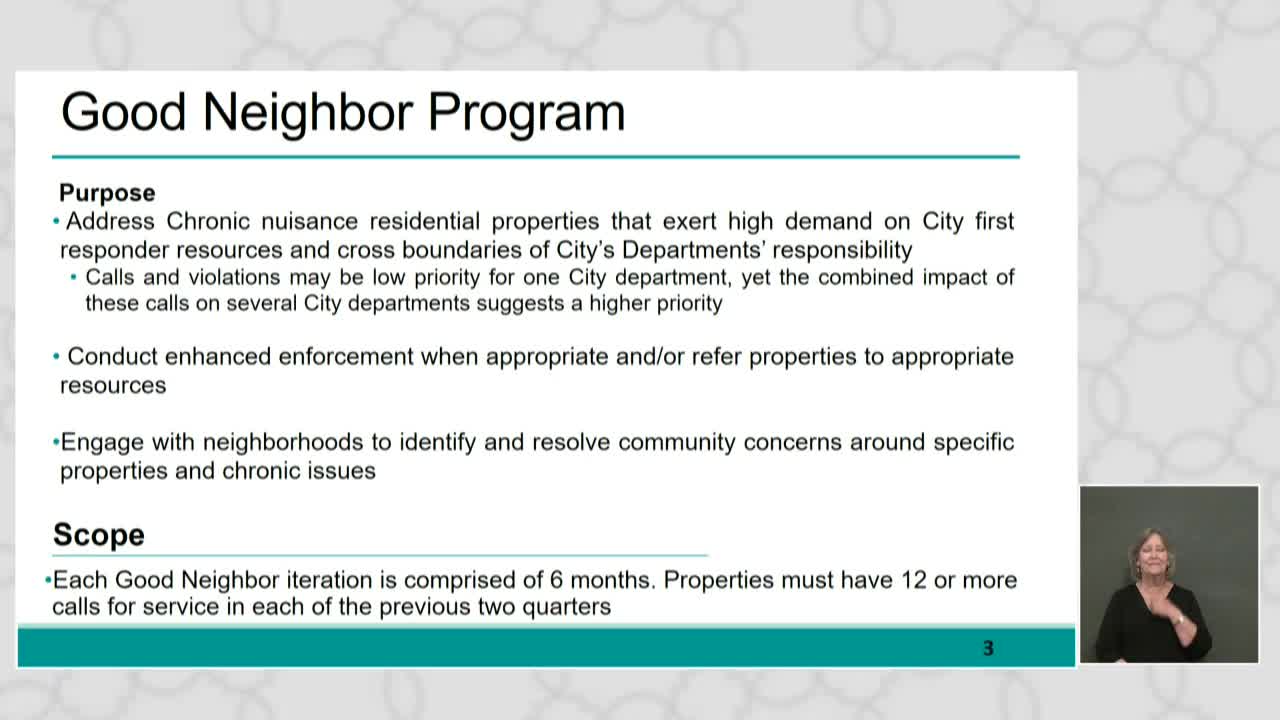Committee hears update on Good Neighbor pilot targeting properties with frequent 311/911 calls
April 15, 2025 | San Antonio, Bexar County, Texas
This article was created by AI summarizing key points discussed. AI makes mistakes, so for full details and context, please refer to the video of the full meeting. Please report any errors so we can fix them. Report an error »

City staff presented an update on the Good Neighbor Program, a six‑month pilot that identifies single‑family properties generating sustained high volumes of 311 and non‑emergency 911 calls and develops coordinated, cross‑department action plans.
María Vargas, who led the briefing, said the program began as a citywide effort in April 2023 to coordinate responses across departments for properties that create repeated service demands. Vargas described the candidate criteria used for the pilot as single‑family addresses with a high volume of combined calls; within the analyzed February–May 2023 window staff identified 707 single‑family residences generating a combined 15,888 calls. The pilot narrowed to the 25 properties with the highest call volumes for targeted plans; Vargas reported an average of 78 calls for those properties, with a maximum of 167 and a minimum of 33 during the referenced period.
Vargas outlined the program workflow: identify candidates by call history, evaluate property and safety constraints, develop a tailored plan, carry out field operations, and monitor and adjust. She said the program is in “phase 2,” which began in January 2025 and includes a six‑month evaluation period. Among the program’s goals are directing residents to appropriate resources, reducing repeat calls, and coordinating departmental action rather than siloed responses.
Members pressed staff on enforcement and timelines. One councilmember asked what happens after six months if a property has not complied; staff said the status could remain “active,” move to maintenance, compliance, deferral, or other statuses depending on progress and departmental enforcement options. Councilmembers repeatedly urged clearer paths to accountability, including the city attorney’s office and municipal court processes where appropriate.
Several councilmembers requested that staff share addresses of high‑call properties with council offices for local follow‑up while maintaining any required privacy protections; staff agreed to meet with council offices and said they would provide lists in that context. Members also discussed capacity constraints — including limits in outreach staffing — and the need to consider resources in the next budget cycle if the program expands.
Vargas said staff will return with a summary of the six‑month evaluation and recommended next steps, including any proposed operational or budget changes.
María Vargas, who led the briefing, said the program began as a citywide effort in April 2023 to coordinate responses across departments for properties that create repeated service demands. Vargas described the candidate criteria used for the pilot as single‑family addresses with a high volume of combined calls; within the analyzed February–May 2023 window staff identified 707 single‑family residences generating a combined 15,888 calls. The pilot narrowed to the 25 properties with the highest call volumes for targeted plans; Vargas reported an average of 78 calls for those properties, with a maximum of 167 and a minimum of 33 during the referenced period.
Vargas outlined the program workflow: identify candidates by call history, evaluate property and safety constraints, develop a tailored plan, carry out field operations, and monitor and adjust. She said the program is in “phase 2,” which began in January 2025 and includes a six‑month evaluation period. Among the program’s goals are directing residents to appropriate resources, reducing repeat calls, and coordinating departmental action rather than siloed responses.
Members pressed staff on enforcement and timelines. One councilmember asked what happens after six months if a property has not complied; staff said the status could remain “active,” move to maintenance, compliance, deferral, or other statuses depending on progress and departmental enforcement options. Councilmembers repeatedly urged clearer paths to accountability, including the city attorney’s office and municipal court processes where appropriate.
Several councilmembers requested that staff share addresses of high‑call properties with council offices for local follow‑up while maintaining any required privacy protections; staff agreed to meet with council offices and said they would provide lists in that context. Members also discussed capacity constraints — including limits in outreach staffing — and the need to consider resources in the next budget cycle if the program expands.
Vargas said staff will return with a summary of the six‑month evaluation and recommended next steps, including any proposed operational or budget changes.
View full meeting
This article is based on a recent meeting—watch the full video and explore the complete transcript for deeper insights into the discussion.
View full meeting
